This post may contain affiliate links. Please read our disclosure policy.
Kabocha Squash Soup with turmeric, ginger, and coconut milk is so rich and creamy! Made with Japanese pumpkin, aromatic shallot, and warming spices, this Asian-inspired soup achieves great depth of flavor with few ingredients. It’s perfect for fall and winter meals!
It’s easy to make, with options to boil or roast your squash for maximum flavor and it’s ready in under an hour. If you love kabocha, try this Simmered Japanese Pumpkin with chicken and enoki mushrooms.
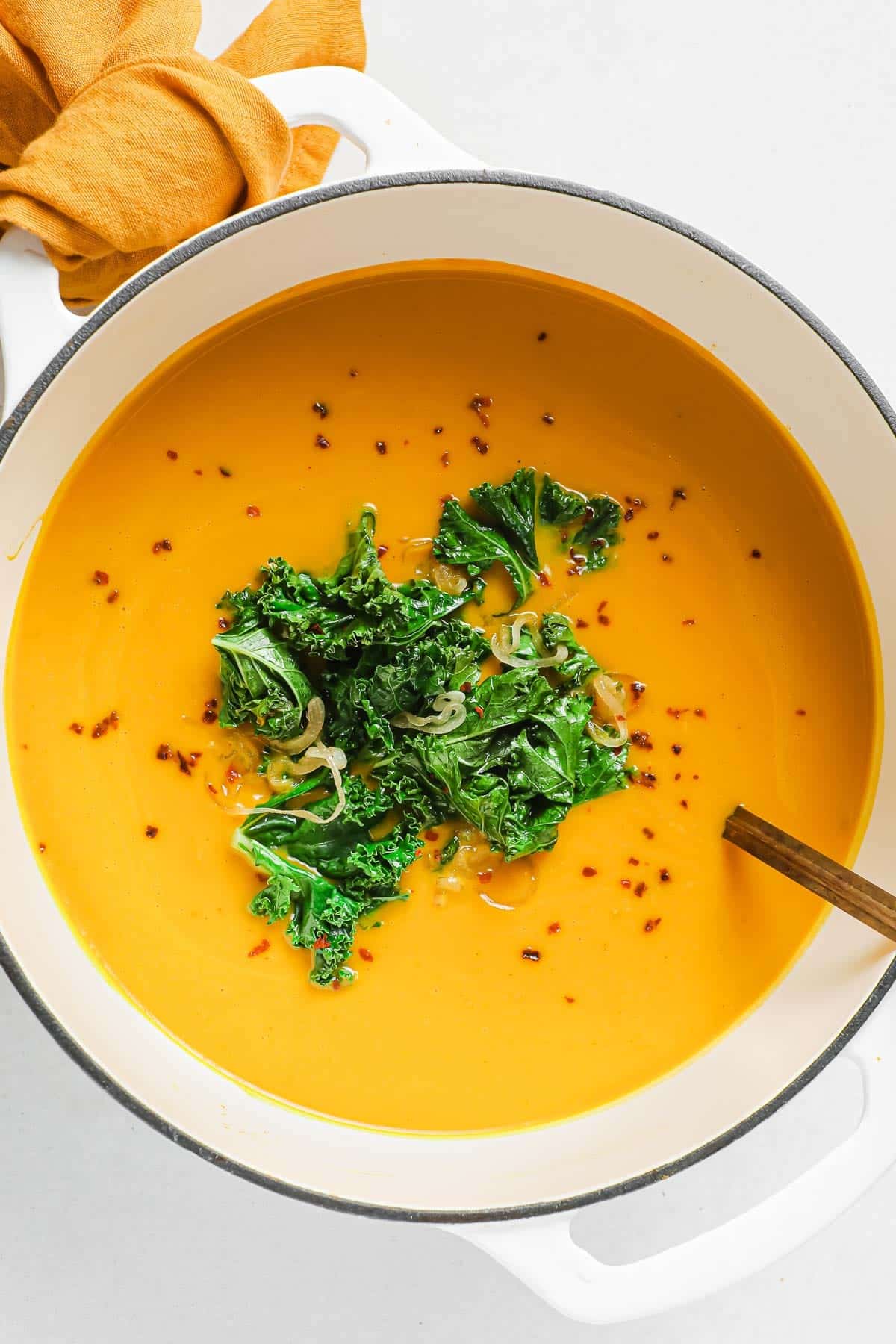
Table of Contents
What is kabocha and how to flavor it?
Kabocha, or Japanese pumpkin, has a sweet, earthy flavor that’s perfect for soups. It usually has dark green skin but also comes in orange or red varieties, all sharing a rich, creamy texture.
For seasoning, kabocha works well with warm spices like cinnamon, turmeric, and ginger. These spices enhance its natural sweetness and add depth, making the soup cozy and full of flavor.

Save This Recipe
Ingredients
All you need to make this rich and creamy soup with kabocha squash, aromatic shallot, buttery ghee, and warming spices. Freshly grated ginger brings the flavor to another level. Turmeric adds earthiness and a beautiful color. It’s so simple yet incredibly satisfying.
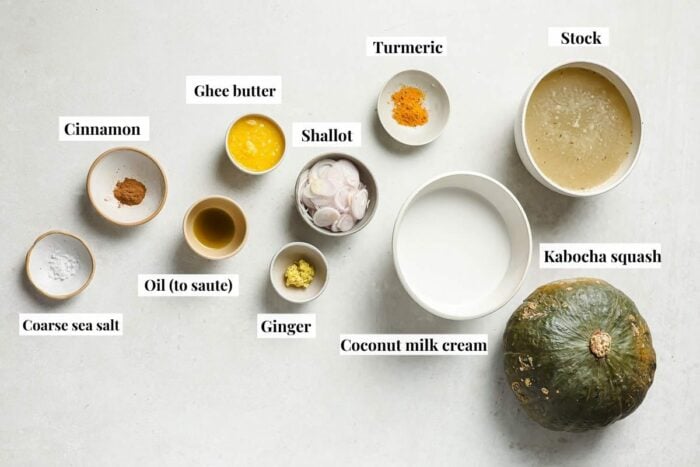
- Kabocha squash: One medium squash. It should feel heavy and be fairly ripe, but not mushy.
- Ghee butter: You can also use regular butter or olive oil. I like the rich flavor of ghee.
- Shallot: Or yellow onion.
- Coarse sea salt
- Chicken stock: For a vegan soup, use vegetable broth or vegetable stock.
- Turmeric powder: Adds an earthy flavor and brightens the color of the soup.
- Cinnamon powder: For warmth and subtle sweetness. I like Vietnamese cinnamon, but any kind will work.
- Full-fat coconut milk: For thickness, creaminess, and healthy fat. If you’re not sensitive to dairy, you can also use creamer or half-and-half.
- Grated ginger for a pop of flavor
- Red pepper flakes (optional): A great garnish if you like a bit of spice.
Don’t toss those kabocha squash seeds! They’re packed with fiber and make a tasty, healthy snack. Just rinse them, pat dry, toss with oil and salt, then roast or air fry for a crunchy treat. Check out my Whole Roasted Butter Squash recipe for full instructions.
How to make kabocha squash soup
This kabocha pumpkin soup dish is so easy to make, and it’s ready in under an hour with minimal prep. Read on to learn how to cut your squash, whether or not to peel it, and how long to simmer kabocha for soup.
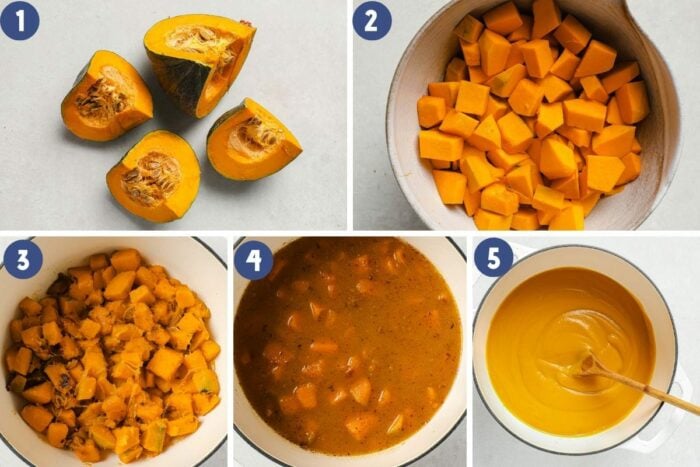
- How to cut kabocha squash: Microwave for 3 minutes to soften the skin. Use a sharp knife to cut the kabocha into quarters. Remove the seeds, peel the skin, and dice into cubes.
- Saute: Melt the ghee or butter in a large Dutch oven or soup pot. Add the shallots and salt and saute until fragrant. Add the squash flesh and saute for about 5 minutes.
- Season and simmer: Add enough broth to cover the squash and season with cinnamon and turmeric. Bring to a boil, reduce heat, and simmer for 10-12 minutes to soften the squash.
- Blend: Use an immersion blender to blend until creamy and smooth.
- Finish: Add the coconut milk and gently simmer over medium-low heat. Stir in the grated ginger. Taste and seasonings to your liking.
- Garnish and serve: Ladle the soup into individual serving bowls. Garnish with a sprinkle of red pepper flakes. Serve hot or at room temperature.
Option to Intensify the flavor
Use roasted kabocha: Intensify the flavor by roasting instead of boiling it. Toss the squash with oil and herbs, and roast at 400°F (200°C) for 25-30 minutes until caramelized and tender. This adds a deep, rich flavor to your soup.
Should you slice off the skin? If you’re roasting kabocha squash, no need to peel! Just like acorn and delicata squash, the skin turns tender and adds flavor. If not roasting, slice off the skin to remove some bitterness.
Kabocha soup pairing
This Japanese squash soup is a great addition to any meal in the fall or winter. It pairs well with your favorite protein, grain, vegetables, and salad. Here are some of my favorites:
- Fall squash: For a delightful fall spread, try my cinnamon cranberry Roasted Delicata Squash, honey parm Air Fryer Delicata Squash, or easy Air Fryer Zucchini and Squash.
- Fresh bread: What’s better than soup and freshly baked bread? This easy Paleo Bread is low-carb, gluten-free, and great for toasting and sandwiches!
- Protein: Round out your meal with healthy protein, like this gluten-free crunchy Baked Cod with Panko. Air Fryer Salmon Bites or Garlic Butter Steak Bites are amazing, too!
Umami tips
- Soften the kabocha skin: Microwave the squash for 3 minutes before cutting. This softens the tough skin, making it easier and safer to slice.
- Use a rocking motion to cut: When slicing the kabocha, avoid cutting through the stem. Rock the knife back and forth gently for more control.
- Perfect simmering time: Simmer the kabocha squash for 12-15 minutes, just until it’s fork-tender. This timing ensures a creamy texture without turning the soup watery.
- Optional roast for more flavor: For deeper, richer flavor, roast the kabocha squash at 400°F for 25-30 minutes before adding it to the soup.
- Kabocha squash substitute: If you can’t find kabocha, use a mix of ripe acorn squash, pumpkin, and sweet potato for a similar flavor and texture.
FAQs
If the squash is roasted, there’s no need to peel the skin—it becomes tender and adds flavor. If you’re not roasting it, it’s best to slice off the skin with a sharp knife to remove some of the bitterness.
If you can’t find kabocha, a combination of ripe acorn squash, pumpkin, and sweet potato works well. These winter squash subs offer a similar sweet, earthy flavor and creamy texture.
More healthy soup recipes you might like
If you love this Japanese pumpkin soup, give some of my other healthy, homemade soup recipes a try.
- Paleo Pumpkin Soup is buttery, naturally sweetened with applesauce, and creamy delicious.
- Chicken Kale Soup with shredded chicken, bacon crumbles, and loads of veggies in a creamy coconut broth.
- Ham and Potato Soup made simple with leftover holiday ham in a buttery, chowder-like base. It’s chunky, full of flavor, and so comforting!
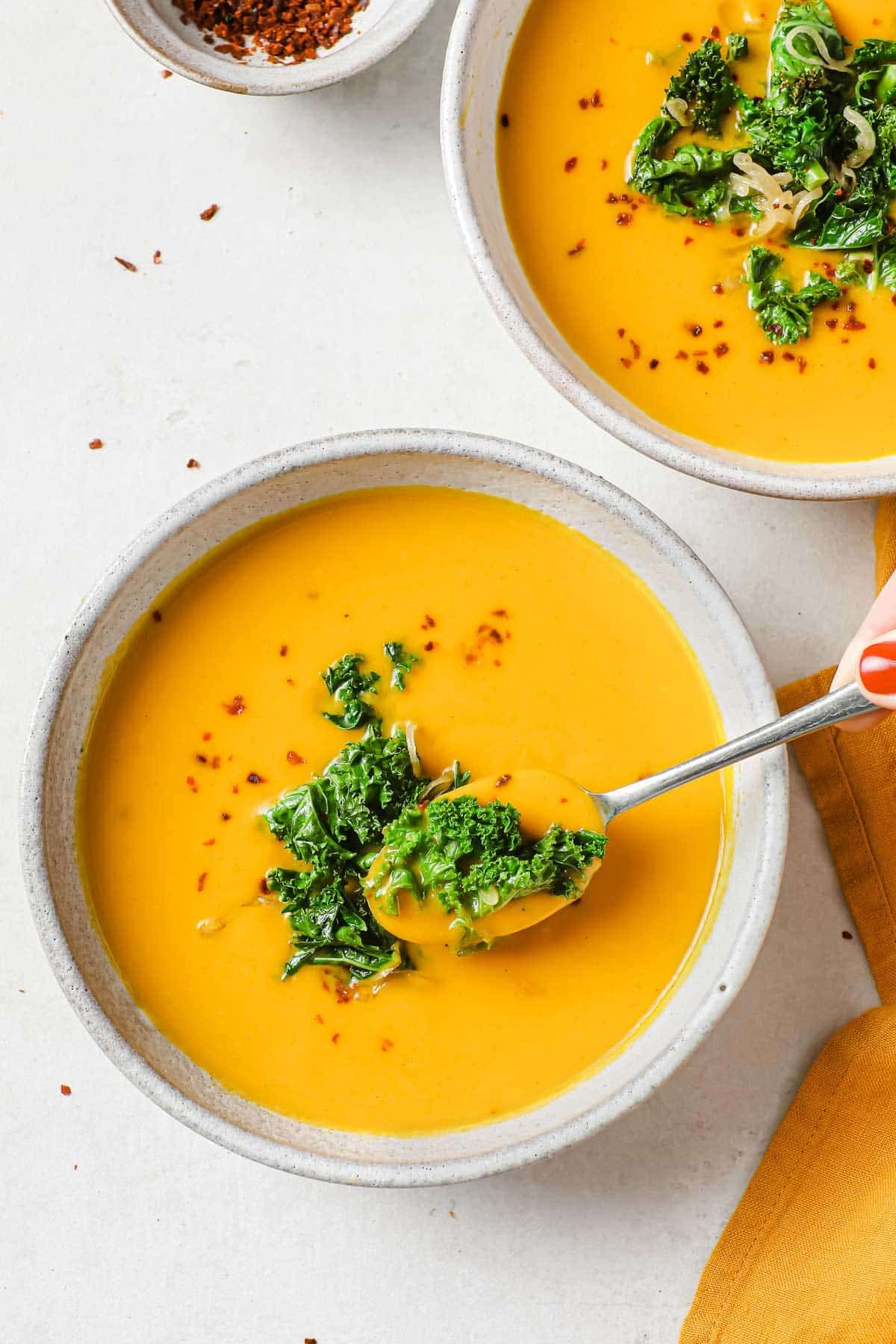
Kabocha squash soup recipe with turmeric ginger
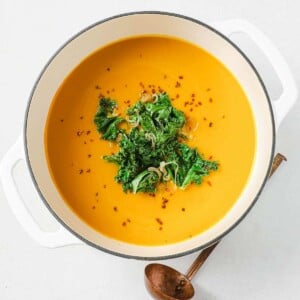
Ingredients
For the soup:
- 2 lb kabocha squash 1 medium size
- 2 tbsp ghee butter
- 1 large shallot thinly sliced
- ½ tsp coarse sea salt or to taste
- 24 oz. chicken stock 3 cup, or vegetable stock
- ¼ tsp Turmeric powder
- ¼ tsp (Vietnamese) cinnamon powder
- 14 oz. Full-fat coconut milk cream
- 1 tsp fresh grated ginger
- Sprinkle red pepper flakes optional
Instructions
Preparing kabocha:
- Place kabocha on a microwave-safe plate and microwave on high for 3 minutes. This helps to soften the kabocha skin just a bit.
- Use a sharp knife to cut the kabocha in half, avoid cutting through the center stem point section. Carefully wiggle your knife in a rocking motion. Do this slowly. Cut the half kabocha further into (4) quarter pieces.
- Scoop out the seeds with a spoon and remove the skin with a knife. Dice it further to similar small cube sizes.
Making the soup:
- Preheat a large (6 qt.) dutch oven or heavy soup pot with ghee. Once melted, add shallots and a small pinch of salt and saute until fragrant, about 1 minute. Add kabocha, season with 2 pinches of salt, and saute until the squash is slightly softened about 5 minutes.
- Add stock, it should be just enough to submerge the squash, turmeric, and cinnamon powder. Give a stir and cover with a lid. Cook over medium heat to bring the broth to a boil, Once boiling, reduce the heat to simmer for an additional 12-15 minutes. The squash should be soft when you can easily poke it through with a butter knife or fork.
- Slowly and carefully use an immersion blender to blend until creamy and smooth.
- Add the milk cream and bring it to a gentle simmer over medium-low heat. Stir in 1 tsp grated ginger. Taste and add more spices or salt to your preference.
Serving:
- Ladle the soup into individual serving bowls. Garnish with a touch of pepper flakes, if adding. Serve hot or warm.
Optional kale topping:
- Preheat a large skillet over medium heat. When it feels warm, add 2 tbsp oil, shallots, and a pinch of salt. Sauté until fragrant.
- Add the kale, and sauté for 1 minute then add the broth and lower the heat to medium-low. Cover the skillet with a lid and allow the kale to cook for a few additional minutes until tender but not mushy and still in vibrant green. Season with more salt to taste.
Notes
- Optional sauteed kale topping:
- 1 bundle of curly kale, discard stems and roughly chopped
- 1 large size shallots, slice into thin strips
- 2 tbsp avocado oil
- Coarse sea salt, to taste
- 2 tbsp chicken stock, or water
- Kabocha squash substitute: Can’t find kabocha? Use a mix of ripe acorn squash, pumpkin, and sweet potato for similar flavor and texture.
- Make-ahead: Prep the squash by slicing, dicing, and removing seeds. Store in the fridge with paper towels in an airtight container for up to 2-3 days.
- Fridge: Keep the soup fresh in an airtight container in the fridge for 4-5 days.
- Freezer: This soup freezes well! Store it for up to 3 months.
Nutrition
Nutrition information is automatically calculated, so should only be used as an approximation.
Made a dish and loved it? Please rate the recipe and leave a comment in the section below! It helps my blog grow organically, allowing me to continue sharing free and awesome content with you. Thank you!
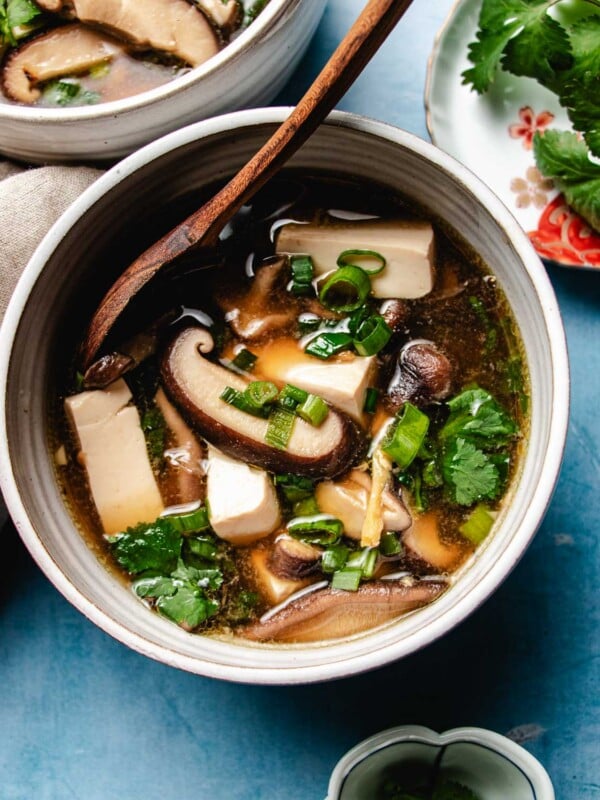
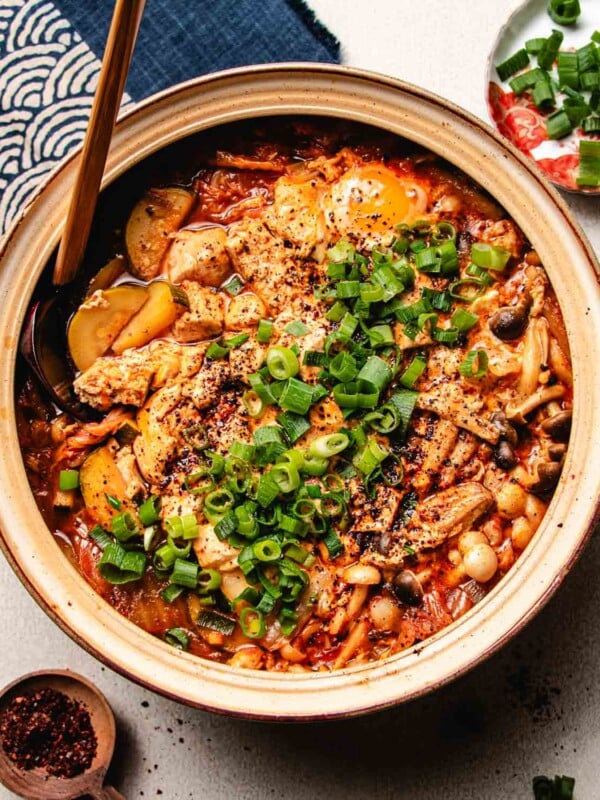
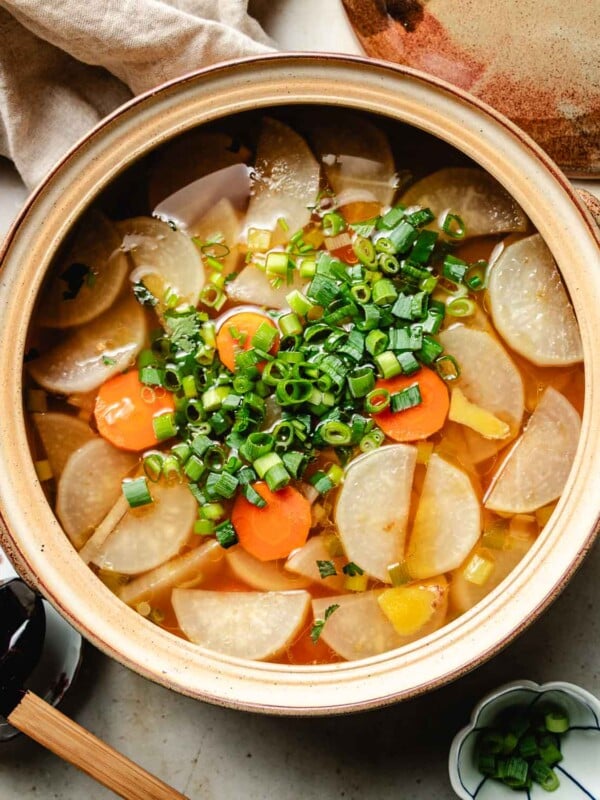










This is such a simple to make delicious recipe! I added some fried shallots and fresno chilies to the top. Would also be great with some crispy pork bacon or sausage. Don’t be intimidated by not having exact measurements. Have fun and taste as you season for the right amount of seasonings for you.
It was delicious! I added fried onions, omitted the kale and didn’t blend it.